3 Storytelling in the classroom
Now try this activity.
Activity 4: Tell a story in simple English
Choose a very short story your students already know well. It could be a story everyone knows from life, or from the textbook. It is helpful if the story has a repeating word or phrase, as this gives you and students more opportunities to practice.
Prepare a very simple English version of this story. Before you tell the story to students, practise it at home, or practise with a fellow teacher.
You can use word cards for key vocabulary in the story, or write these words on the blackboard.
Now read the lesson plan in Resource 1. Adapt it to suit your classroom, the needs of your students and your own professional development.
With students, tell the story slowly. Use pictures or gestures to mime the story as you speak. Let students guess at the meaning of your words.
After you tell the story, let the students practise telling it themselves. If there are students with hearing problems in your class, let other students mime the story to them.
Let the session be enjoyable. You do not need to attach any language drills or writing practise to the storytelling.
After a storytelling session, make brief notes about individual students, using criteria such as:
- listens carefully
- shows involvement (comments, asks questions)
- is able to use some English words and phrases in a story
- is able to tell a story partly in English
- is able to tell a story in English.
You can do this for small groups of students throughout the year.
Activity 5: Preparing for storytelling in the classroom

To gather the class together and prepare students to listen to a story, you can ring a story time bell or beat a story time drum. You can say a rhyme or sing a version of ‘If You’re Happy and You Know It’:
If you want to hear a story, clap your hands!
If you want to hear a story, clap your hands!
If you want to hear a story, if you want to hear a story,
If you want to hear a story, clap your hands!
Practise and use these English phrases for storytelling in your classroom:
- ‘It’s story time!’
- ‘Sit down, everyone.’
- ‘Are you ready?’
- ‘Is everyone ready to listen?’
- ‘Are you ready to listen?’
- ‘Listen to me.’
- ‘Who is listening?’
- ‘Repeat after me …’
- ‘Say it with me …’
- ‘Let’s say together …’/‘Say it with me …’
- ‘Now you say it.’
- ‘You are good listeners!’
- ‘You are good storytellers!’
If you set in place such routines, managing a large class and/or multigrade class for storytelling becomes easier, and students can join in and practise English with you.
See Resource 2, ‘Storytelling, songs, role play and drama’, to learn more about extending the potential of stories in your classroom.
Video: Storytelling, songs, role play and drama |
2 Using simple stories
